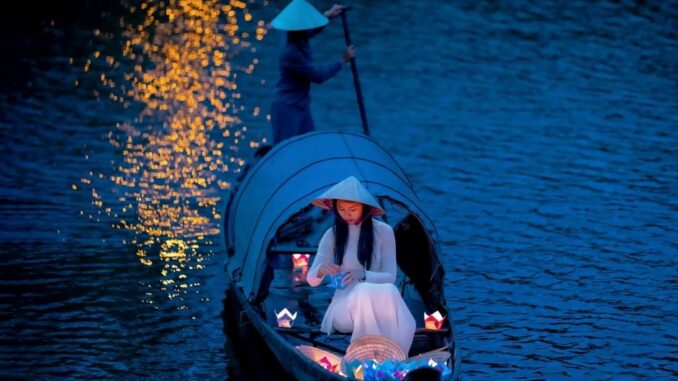
The land of the ancient capital attracts visitors by its poetic landscape, ancient architecture, and the idyllic pace of life of the people.

Schoolgirls in white ao dai ride bicycles filled with phoenix flowers across Truong Tien Bridge, evoking the gentleness of Hue women.
Truong Tien Bridge is one of the symbolic works of the city, crossing the Perfume River. People here are familiar with the song “Truong Tien Bridge has six spans, twelve spans…”, but exactly the bridge has six spans and 12 spans linked together into 6 pairs. The bridge has a length of more than 400 m from two abutments, if, including the path, the length of Truong Tien is about 453 m, the width of the bridge is 6 m.

Perfume River – Ngu Mountain is like a couple that goes together, appearing in many famous songs. The river was also mentioned by writer Hoang Phu Ngoc Tuong in his pen “Who named the river” and was taught in the curriculum of Textbook 12. National high school exam essay 2019.

Two foreign tourists strolling to see sculptures at 3-2 Park. Located on Le Loi Street with many trees, shade and stone benches, this is the entertainment place of city people in particular and tourists from near and far in general when coming to Hue.

Two women chatting in a park on the banks of the Perfume River.
“It is difficult to use words to describe the quiet beauty and the most simple things of the ancient capital. I live and work here, using photography to bring the beauty of the land to introduce to everyone,” the photo author shared.

Tourists walk on the road along the north bank of the Perfume River during the season of changing leaves. Hue people consider the Perfume River a heritage river, so the landscape on both sides of the river is always focused.
The north bank route becomes a place for walking, playing and exercising for residents in the area, and also “connects” to other destinations such as Phu Xuan park, Nghinh Luong Dinh relic, Phu Van Lau, etc. Thuong Bac Park, Truong Tien Bridge and Dong Ba Market.

Traffic is quiet on Huynh Thuc Khang Street, Phu Hoa Ward.

Hue preserves the architecture and customs of the Nguyen Dynasty, the last feudal dynasty of Vietnam. In addition to typical tourist attractions such as the Imperial City, visitors can also visit the mausoleums of kings.
Two tourists walking in the Tomb of Khai Dinh. The mausoleum is located on the slopes of Chau Chu mountain in Thuy Bang commune, Huong Thuy Town, is the resting place of King Khai Dinh (1885-1925). Construction of the mausoleum was started in 1920, 11 years later it was completed with the current architecture.

White lotus pond in full bloom in Phuoc Tich ancient village. Located 35 km north of Hue city center. The village is located peacefully on the bank of O Lau River, bordering Thua Thien – Hue province and Quang Tri province.
With an age of over 500 years and has been classified as a national monument, this place stands out with images of communal houses, banyan trees, water wharves, fields and white lotus ponds.

Tourists pose with red maple leaves on Bach Ma National Park, about 40 km from the center of Hue city. This is the only forest in Hue with red maple leaves. On Bach Ma mountain, the highest point is Vong Hai Dai – 1,400 m above sea level.
In the forest campus, there are ancient villas of French architecture, and next to it are maple trees that grow naturally with the age of over 100 years. According to the rangers, these maples only turn red in the spring, from about January to February, unlike many other places where they often have red leaves in the fall.

Two female urban construction workers take a break in front of Dong Ba market.
This market is located on Tran Hung Dao Street, Hue City is the largest market in the province, born under King Dong Khanh (1887). In the past, the market was located near the Dong Ba gate, then King Thanh Thai moved it to its current position.

A young woman wears a white Ao Dai in the scene of releasing Lanterns on Nhu Y river on the occasion of the Hue Festival. The wishes of the old and the young are all sent to the petals of lighted flowers floating on the river, wishing for prosperity, peace, and happiness always.
Photo: Nguyen Tan Anh Phong
